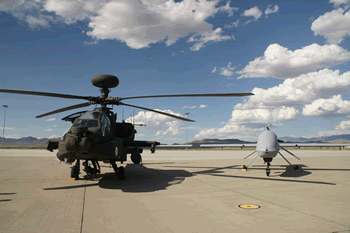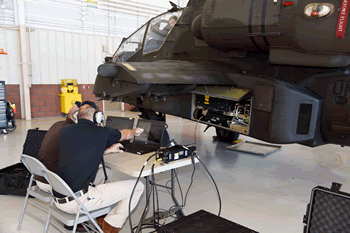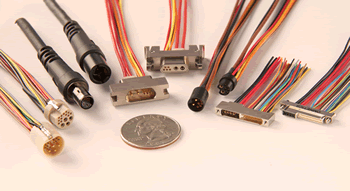Military Tech Advancements in 2016
Military tech advancements for 2016 will sharpen situational awareness and expand capabilities for the warfighter.
Across the Department of Defense, many research and development programs are finding it necessary to change direction in order to adapt to budget cuts. Program managers, expected to advance technology while spending less money, are rising to the challenge with innovations in both tactics and design. The best minds in military research and testing are working to reduce costs—and risk to the warfighter—by strategically teaming assets, developing multipurpose tools, and even radically rethinking existing technology.
Military industry advances for 2016 will feature technology that increases situational awareness and expands the capabilities for the warfighter.
Hybrid Connectors in Manned-Unmanned Teaming
The Apache helicopter has been in a continuous state of evolution since entering service in the US Army nearly two decades ago. With the latest upgrade, the AH-64E Guardian Block III, the military’s most capable attack helicopter, is now more lethal than ever.
The aircraft’s new propulsion system provides a performance boost, with increases in both airspeed and payload capability. The redesign also resulted in substantial reduction in the size of its onboard computer system, with one computer in the right of the front cockpit and a single backup in the left of the rear cockpit. The aircraft’s seven miles of wiring have quick disconnects placed every two feet so wiring damaged by gunfire can be replaced quickly and easily.
The feature at the forefront of Apache Block III technology is the ability to augment the aircraft’s sensors with input from a drone, or unmanned aircraft system (UAS). Known as manned-unmanned teaming (MUM-T), this type of partnering was historically a ground-forces-to-UAS system. In aviation, interoperability with UAS sensors gives the Apache helicopter pilots another set of “eyes,” greatly extending their digital view while keeping them far from enemy fire.

Apache AH-64E Block III attack helicopter and MQ-1C Gray Eagle UAS staged on the flight line in preparation for testing. (Photo courtesy of General Atomics Aeronautical Systems)
That capability digitally integrates the data collected from the UAS, usually an MQ-1C Gray Eagle, and makes it available to the Apache pilot in a virtually seamless manner.
“The sensors on the UAS act the same way as the sensors on the Apache,” says Win Miller, assistant division chief, Attack/UAS Test Division, Redstone Test Center. Video and target data, gathered by UAS sensors, is seen in real time, which allows pilots to quickly identify and engage targets from much greater ranges.
Miller’s division is responsible for the development, testing, and deployment of MUM-T as it advances through increasing levels of interoperability (LOI). At level 1, the Apache received indirect UAS data, meaning verbal communication was required to transmit information from the UAS operator to the helicopter pilot. This was a slow and cumbersome way to gain target intelligence. LOI2, the currently fielded level, allows pilots direct receipt of UAS video and other sensor information through the Apache’s displays. This represents a significant improvement, as pilots can see the sensor input with their own eyes.

Flight test engineers complete manned-unmanned teaming (MUM-T) data link compatibility module (DLCM) level of interoperability two (LOI 2) functionality checks. (Photo credit: Josh Nichols, RTC Photographer)
Currently in development, LOI3 (control of the cameras and sensors on the UAS) and LOI4 (control of the drone’s flight path and payload) will realize the full potential of the MUM-T program.
“At full interoperability, the Apache pilot will be able to fly the UAS, receive data from multiple UAS platforms, and point the UAS sensors at a specific target, resulting in a much faster sensor-to-shooter time,” says Miller.
While it took a lot of software to make this work, he says hardware modifications are necessary, including updated computers and antennae bands. As always with aviation development, the goal is simultaneously to enhance aircraft and pilot capabilities while reducing weight.
Surveillance, reconnaissance, target acquisition, and tracking system engineers continue to develop feature-rich systems for military aircraft, each of which add to power and data transfer requirements. Military flight engineers are continually challenged to integrate the newest equipment without increasing the weight of the aircraft.
The key to meeting SWaP (size, weight, and power) requirements without adding bulk and weight is the use of mixed-signal or hybrid connectors. “The technology that allows pilots to make rapid decisions – quality images and the speed at which those images are received – is impacted by the way we run connectors and cables,” says Bob Stanton, director of technology at Omnetics Connector Corporation.

Omnetics Connector Corporation’s hybrid standard 99 connectors
“We are constantly increasing the speed and number of pieces of information transmitted, while also needing to shield the information from electromagnetic interference,” says Stanton. In addition to developing hybrid power and signal connectors, Omnetics also designed connectors that incorporate coax-to-broadcast in addition to power and signal.
Bringing MUM-T technology full circle, eventually Apache pilots will serve as a critical interface, sharing real-time sensor feeds with ground forces.
LIDAR Envisioned by DARPA
Last month, the Defense Advanced Research Projects Agency (DARPA) opened a proposal in support of the Modular Optical Apertures Building Blocks (MOABB) Program. The research organization wants to change the image collection mechanism in order to make the laser-based 3D imaging systems significantly smaller, lighter, and cheaper. The overarching goal of the program is to develop the advances necessary to build ultra-compact LIDAR systems.
This is not a plan to trim a couple bucks or a few pounds from a government program – the proposed system would involve a technological shrinking act of unprecedented proportions. According to the DARPA notice, “The resulting technology could be a truly disruptive technology that would change what’s possible with surveillance and detection systems of all sizes.”
LIDAR technology, which dates back to the Cold War era, is used in myriad sensing and mapping applications. According to the MIT Technology Review, “LIDAR systems fire lasers and detect returning photons, using the timing of those return trips to measure distance and thus make 3D images.” With high-speed pulses and fine-grained reception, it can create a high-resolution map of the area it’s measuring, as well as track movements in that area.
The cons of LIDAR, however, are many. The technology requires multiple passes of an aircraft over the target area, taking hours to create a picture. The lasers require a tremendous amount of power. Finally, LIDAR use telescopes to collect images. The weight and size of the lenses, mirrors, gears, and motors, not to mention the expense, limit the practical applications of the technology.
MOABB aims to dispose of the telescope and mechanical components and reconstitute the light-gathering and imaging functions of conventional telescopes into an array of 10,000 light-emitting and light-detecting semiconductor dots distributed on a disk about the size of a DVD. With a performance goal equivalent or better than today’s telescope-based LIDAR, it’s a tall order indeed.
“Potential applications, such as foliage-penetrating imagery for spotting hidden threats, could revolutionize situational awareness in non-urban military operations,” says Dr. Joshua Conway, MOABB program manager, in DARPA’s Microsystems Technology Office.
The initial phase of the program calls for researchers to develop the fundamental devices that will underlie the new LIDAR concept: Speck-sized light-emitting and light-detecting cells capable of being readily integrated into larger arrays using typical semiconductor manufacturing processes. Phase 2 and Phase 3 of the project call for the integration of these cells into a 1cm2 array and a 10cm2 array comprising upward of 100 and 10,000 unit cells, respectively.
The opportunity exists for design engineers and cable and connector manufacturers to partner in development of groundbreaking technology. The final LIDAR surface, with the integration of digital, electronic, optical, and radiofrequency elements on a variety of combined semiconductor materials, has potential to be the most complex electronic-photonic circuit ever constructed.
Conway notes while the MOABB program does not have a specification for connectors, the objective LIDAR system will generate data at a high rate.
“In many cases, the connector for the databus, such as 100 Mb/s Ethernet, could have a greater volume than the sensor itself. There are many potential solutions to reduce the size of the interconnects, and this challenge could lead to requirements for novel, specialized connectors in the assembly,” says Conway.
Part 2 of this article, which will feature life-saving technology for airmen, will run in our January 11 issue.
 Author Terri Helus has more than a dozen years experience writing for publications including verticals about military and defense, safety, aviation flight testing, information technology, and veterinary specialty medicine. A former Army public affairs specialist, she honed her skills with the DoD-level, award-winning newspaper, The Citizen. She worked at major military organizations including the US Army Combat Readiness/Safety Center and the US Army Aviation Technical Test Center. She can be reached at [email protected].
Author Terri Helus has more than a dozen years experience writing for publications including verticals about military and defense, safety, aviation flight testing, information technology, and veterinary specialty medicine. A former Army public affairs specialist, she honed her skills with the DoD-level, award-winning newspaper, The Citizen. She worked at major military organizations including the US Army Combat Readiness/Safety Center and the US Army Aviation Technical Test Center. She can be reached at [email protected].



